Quick Links: Rats in New Jersey | Common Types of Mice | Voles | Rodent Control Programs | Rodent Services | New Website
New Jersey Rodent Extermination Services and Rodent Identification
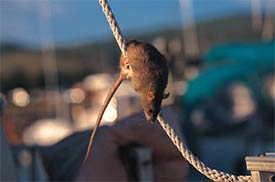 Rodent control is a job for knowledgeable, experienced pest control experts.
Successful rodent exclusion requires that all entry and exit points be identified
and completely sealed to prevent rodents from returning. Amateurs who attempt
do-it-yourself rodent control risk dangerous exposure to the many harmful parasites
and diseases rodents carry. Improperly administered poisons can trap
dying rodents inside walls where the stench of their decomposition can be nauseating
and drive away customers. Home and business owners can aid in rodent control
by eliminating attractants, following good sanitation practices and maintaining
their property in good repair.
Rodent control is a job for knowledgeable, experienced pest control experts.
Successful rodent exclusion requires that all entry and exit points be identified
and completely sealed to prevent rodents from returning. Amateurs who attempt
do-it-yourself rodent control risk dangerous exposure to the many harmful parasites
and diseases rodents carry. Improperly administered poisons can trap
dying rodents inside walls where the stench of their decomposition can be nauseating
and drive away customers. Home and business owners can aid in rodent control
by eliminating attractants, following good sanitation practices and maintaining
their property in good repair.
Allison Pest Control offers rodent trapping, rodent monitoring and rodent exclusion to fight rodent infestations. Allison Pest Control's rodent control experts use this pest's habits against it to control infestations. Rodents are curious and will investigate new objects in their environment. They are also creatures of habit that follow known pathways. When rodent activity is discovered, Allison Pest Control rodent control experts will carefully inspect the entire premises both inside and out to locate entry and exit points and traffic paths being used by rodents. Our rodent exclusion recommendations should be followed quickly to seal larger access points as soon as possible to discourage rodent activity.
Rodent Trapping. Allison Pest Control uses only the industry's most effective rodent snap and glue traps. Traps are baited with a non-toxic bait that is not harmful to pets. Baited traps are carefully placed in rodent pathways for maximum effectiveness. Allison Pest Control technicians inspect traps on a regular basis to remove rodent carcasses and rebait traps as necessary.
Rodent Monitoring. Locked, tamper-proof bait stations are placed around the perimeter of the residential or commercial building by Allison Pest Control's rodent control experts. An anticoagulant rodenticide is used to kill and eliminate problem rodents. Bait stations are regularly inspected and rebaited as necessary.
Rodent Exclusion. Rodent-impervious materials are used to seal accessible rodent entry points 1/4 inch in diameter or larger. Caulking and wire mesh screens are used to prevent rodents from gaining entry to your home or business. Our service technicians will provide this service for small intrusion points as part of our rodent program.
When rodent extermination is complete, discovered nesting sites should be professionally cleaned and disinfected to remove disease organisms and parasites. Because of the serious health risk they pose, rodents should be eliminated quickly when discovered. The combination of Allison Pest Control's rodent trapping, monitoring and exclusion services creates a safe, rodent-free environment that protects your family, employees and customers.
Rats, Mice and Voles Commonly Found in New Jersey
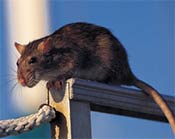 Roof Rats. Also known as "black rats" or "ship rats," roof
rats are a sub-tropical species transported to New Jersey on ships and found
in port cities. Roof rats have smooth black fur with a lighter belly and large
ears and eyes.
Roof Rats. Also known as "black rats" or "ship rats," roof
rats are a sub-tropical species transported to New Jersey on ships and found
in port cities. Roof rats have smooth black fur with a lighter belly and large
ears and eyes.
Weighing 10 to 12 ounces, their bodies are 6 to 8 inches long with exceptionally long, scaly tails that more than double their length and are used for balance. Adept climbers, roof rats live in the upper branches of tall trees but have adapted to inhabit the upper stories of tall buildings.
Roof rats will feed on anything but prefer fruit, vegetables and cereal grains. These rodents can consume massive amounts of food at one time and pose a serious threat to stored foods. Roof rats carry fleas and mites and spread bubonic plague.
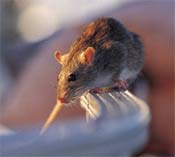 Norway Rats. The most common rodent in U.S. cities, Norway rats are also known
by their color and common habitats as "brown rats," "gray
rats," "sewer rats," "water rats" and "barn
rats." Gray or brown with a whitish belly, Norway rats are coarse-furred
with small ears and a blunt nose. Weighing 11 ounces with stout 7 to 10-inch
long bodies, Norway rats have scaly, semi-naked tails that are shorter than
their bodies.
Norway Rats. The most common rodent in U.S. cities, Norway rats are also known
by their color and common habitats as "brown rats," "gray
rats," "sewer rats," "water rats" and "barn
rats." Gray or brown with a whitish belly, Norway rats are coarse-furred
with small ears and a blunt nose. Weighing 11 ounces with stout 7 to 10-inch
long bodies, Norway rats have scaly, semi-naked tails that are shorter than
their bodies.
Living in large colonies in close proximity to people, Norway rats build extensive underground burrows joined by interconnecting tunnels. These rodents often burrow under buildings or invade lower floors but may inhabit garbage dumps, ponds, sewers and wood piles.
Norway rats will eat anything but prefer meat and fresh grains. A public health menace, Norway rats carry fleas and other dangerous parasites and transmit dangerous diseases including toxoplasmosis and potentially fatal Hantavirus pulmonary syndrome.
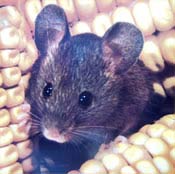 House Mouse. The most common indoor rodent, the house mouse has short gray
or brown hair with a lighter-colored belly, small eyes and large, nearly hairless
ears. Weighing 1/2 ounce, the house mouse is 2 inches long with a long, thin,
nearly hairless tail longer than its body. House mice can live in outdoor burrows
but prefer to live indoors where they will spend their lives within 10 feet
of their nest when adequate food and water are present.
House Mouse. The most common indoor rodent, the house mouse has short gray
or brown hair with a lighter-colored belly, small eyes and large, nearly hairless
ears. Weighing 1/2 ounce, the house mouse is 2 inches long with a long, thin,
nearly hairless tail longer than its body. House mice can live in outdoor burrows
but prefer to live indoors where they will spend their lives within 10 feet
of their nest when adequate food and water are present.
In food storage facilities, a house mouse may live his entire life on a single pallet of food. A constant nibbler, the house mouse has a preference for cereal grains but will sample several foods in a single night.
As house mice forage, they constantly dribble urine and feces, fouling food preparation areas and contaminating food supplies. The house mouse carries ticks, lice and mites indoors and transmits salmonella pathogens that cause food poisoning.
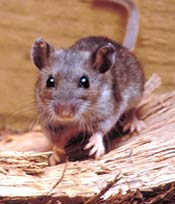 Deer Mouse. Also know as the "field mouse," the deer mouse is
slightly larger than the house mouse and lives in weedy fields and grassy prairies.
The deer mouse is about 3 inches long and weighs about an ounce.
Deer Mouse. Also know as the "field mouse," the deer mouse is
slightly larger than the house mouse and lives in weedy fields and grassy prairies.
The deer mouse is about 3 inches long and weighs about an ounce.
Brown with a white belly and white feet, the deer mouse has large, bulging eyes, big ears and a short-haired, bi-colored tail as long as its body that is dark on top and white underneath. Deer mice feed on seeds and berries and burrow under rocks, boards and haystacks.
Deer mice are rare home invaders but may seek harborage when construction destroys their habitat, preferring undisturbed areas like attics. Deer mice carry Lyme disease-transmitting deer ticks and spread Hantavirus.
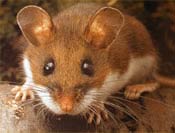 White-Footed Mouse. Also known as the "wood mouse," the white-footed
mouse shares many characteristics and is often confused with the deer mouse.
Named for its distinctive white feet, the white-footed mouse is light brown
with a white belly and large eyes and ears.
White-Footed Mouse. Also known as the "wood mouse," the white-footed
mouse shares many characteristics and is often confused with the deer mouse.
Named for its distinctive white feet, the white-footed mouse is light brown
with a white belly and large eyes and ears.
About 3 inches long, it weighs just under one ounce and has a narrow tail half its body length. White-footed deer mice feed on seeds, nuts, insects and plants.
Good swimmers, the white-footed mouse lives in marshes and wooded areas, nesting in underground burrows and often invading empty summer cottages. When food sources dwindle in autumn, these rodents may forage in garages for birdseed. The white-footed deer mouse carries Lyme disease-bearing deer ticks and transmits Hantavirus.
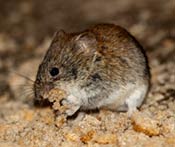 Voles. Small mouse-like rodents, voles are actually related to muskrats and
lemmings. Voles weight 1 to 2 ounces and have short-furred, brown bodies 2
to 3 inches long with a grayish underbelly.
Voles. Small mouse-like rodents, voles are actually related to muskrats and
lemmings. Voles weight 1 to 2 ounces and have short-furred, brown bodies 2
to 3 inches long with a grayish underbelly.
Voles have a rounder head and stouter body than mice with tiny eyes, small, partially hidden ears and a stubby, hairy tail. Adroit diggers, voles tunnel under the ground or travel through vacated mole tunnels to feed on plant roots, tubers and bulbs. In the winter, voles feed on bark, girdling and killing young trees.
Voles do not enter homes but are highly destructive to gardens, landscape plantings, ornamental plants and lawns.












